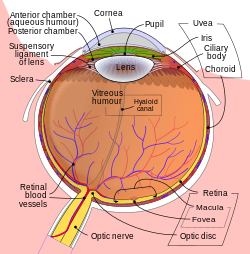Camera-type eye
| Eye | |
|---|---|

Human eye
|
|

Compound eye of Antarctic krill
|
|
| Details | |
| System | Nervous |
| Identifiers | |
| Latin | oculus |
| TA |
A15.2.00.001 A01.1.00.007 |
| FMA | 75665 |
|
Anatomical terminology
[]
|
|
Eyes are organs of the visual system. They provide organisms vision, the ability to process visual detail, as well as enabling several photo response functions that are independent of vision. Eyes detect light and convert it into electro-chemical impulses in neurons. In higher organisms, the eye is a complex optical system which collects light from the surrounding environment, regulates its intensity through a diaphragm, focuses it through an adjustable assembly of lenses to form an image, converts this image into a set of electrical signals, and transmits these signals to the brain through complex neural pathways that connect the eye via the optic nerve to the visual cortex and other areas of the brain. Eyes with resolving power have come in ten fundamentally different forms, and 96% of animal species possess a complex optical system. Image-resolving eyes are present in molluscs, chordates and arthropods.
The simplest "eyes", such as those in microorganisms, do nothing but detect whether the surroundings are light or dark, which is sufficient for the entrainment of circadian rhythms. From more complex eyes, retinal photosensitive ganglion cells send signals along the retinohypothalamic tract to the suprachiasmatic nuclei to effect circadian adjustment and to the pretectal area to control the pupillary light reflex.
...
Wikipedia
